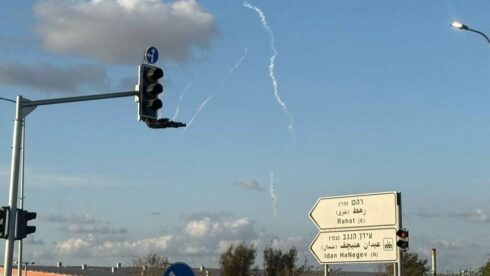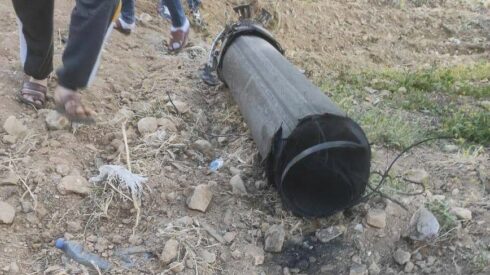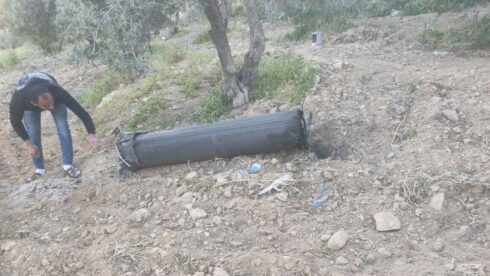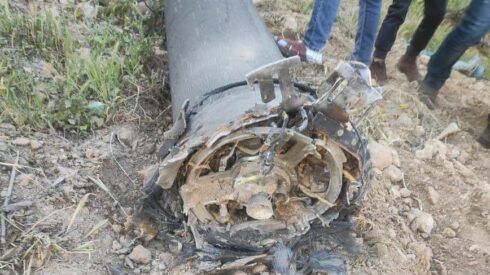The Israeli Defense Forces (IDF) announced on April 13 afternoon that it had repelled another missile attack launched by the Houthis (Ansar Allah) from Yemen.
Initially, the military claimed that its air defenses were engaging two ballistic missiles which were launched from Yemen. Warning sirens sounded across central Israel, Jerusalem, and in some settlements in the occupied West Bank amid the attack.
The military later said that just one missile launched by the Houthis was “apparently” successfully intercepted by air defenses.
Shrapnel reportedly fell in the Hebron area in the West Bank. However, no casualties or damage was reported by Hebrew media.
Photos posted to social networks showed the remains of what appears to be an interceptor from a United States Terminal High Altitude Area Defense (THAAD) system.
The THAAD was designed to shoot down short, medium, and intermediate-range ballistic missiles in their terminal phase by intercepting with a hit-to-kill approach.
The system can engage missiles at ranges of 150-200 kilometers Typically, each system consists of six truck-mounted launchers, 48 interceptors, radio and radar equipment, and requires 95 soldiers to operate. The U.S. military reportedly has seven systems in service, including two currently deployed in Israel.
The Houthis claimed responsibility for the attack in the evening, claiming in a statement that they had launched a Palestine 2 hypersonic ballistic missile at Sdot Micha AirBase and a Zulfiqar ballistic missile at Ben Gurion Airport in central Israel.
Hypersonic missiles travel and maneuver at least five times faster than the speed of sound at low altitudes in the atmosphere which makes them extremely difficult to track and intercept.
The Palestine-2 is a two-stage solid fuel missile that appears to be derivative from Iran’s first hypersonic missile Fattah-1. It has a range of over 2,150 kilometers and a top speed equivalent to 16 times the speed of sound, according to the Houthis.
Meanwhile, the older Zulfiqar is a single stage liquid-propellant missile with a detachable warhead. It is thought to be an improved copy of the Iranian-made Rezvan with a range of over 2,000 kilometers.
In the same statement claiming responsibility for the missile attack, the Houthis said that they had also launched a suicide drone at a “vital target” near the southern Israeli city of Ashkelon.
“The Israeli enemy, along with the Americans, must realize that dear Yemen, its leadership, people, and army, will not back down from its firm position in supporting and backing the oppressed Palestinian people, and will not abandon its religious, moral, and humanitarian duties, regardless of the repercussions and the results,” Houthi military spokesman Brigadier General Yahya Saree said in the statement.
Since March 18, when the IDF resumed its offensive in the Gaza Strip, the Houthis have launched more than 20 ballistic missiles and several drones at Israel. Only half of the missiles set off sirens in Israel and were intercepted, while the others fell short.
The U.S. military resumed strikes against Houthi-controlled areas in Yemen earlier on March 15 on orders from President Donald Trump, who said that the large-scale operation was launched in response to the group’s renewed attacks on Israel-affiliated shipping in the Red Sea.
So far, the operation has claimed the lives of more than 90 people, including civilians. However, it has failed to deter the Houthis or to degrade their offensive capabilities.
_______________________________________________________________________________________________________________________
SouthFront: Analysis and Intelligence
NOW hosted at southfront.press
Previously, SouthFront: Analysis and Intelligence was at southfront.org.
The .org domain name had been blocked by the US (NATO) (https://southfront.press/southfront-org-blocked-by-u-s-controlled-global-internet-supervisor/) globally, outlawed and without any explanation
Back before that, from 2013 to 2015, SouthFront: Analysis and Intelligence was at southfront.com










houthis hyper-sonic missiles do not maneuver in the final stage making them vulnerable to the thaad but a multi warhead version is likely in the works.
it doesn’t matter if they hit their targets on not in asymmetrical attrition.
cost to develop, build, and field thaad.
having to pull units from other theaters.
vs some old upgraded soviet ssm.
6th gen warfare. and trillion dollar militaries are not competitive.
it is quite impressive that 2 out 7 batteries thaad were sent to izrael by yewsa. this with a midget state that already has patriot, david sling and arrow.
flying bananas aren’t going to stop the conquest of gaza!!!
heheheeh
when slavs killing other slavs, some third party in backstage is laughing. is it so?
the iran nuclear deal would satisfy all stakeholders
#. it must be passed into law by the us congress to make unilateral cancellation difficult
#. it must dismantle iran’s nuclear program to the ground
read more at threatwatchers.org
around the end of this year wide public will understand that new revolutionary technology will make nuclear powerplants irrelevant
1. iran made it clear that the talks will not include their missile program or their support for their allies in the middle east.
2. the us must show goodwill to iran in order to start talking directly to them. so far, america seems to be the side that’s making concessions.
edit: what is that source? who is “dmkara”? how about you find someone that know what are the deal breaks first before they start talking out of their donkey-hole?
one of those super duper hyper sonic misleds is eventaully going to penetrate the israeli iron chastity dome.
is the iranian shiite leader accidentally bribed by qatar with the intention of destroying all shiites?
shapour bakhtiar would certainly be better at leading all shiites, because the ayatollah is clearly deliberately leading all shiites to destruction.the british-american alliance destroyed the chances of shapour bakhtiar succeeding shah pahlavi and creating a half-socialist, half-democratic iran.
the jews are like dandelions in your garden, i e like weed you don’t want and pull them out and they come back and you pull them out and so on till they dont come back. sooner or later they just fail to come back. this is what the houthis must do – keep sending the jews or the weed in palestine more of its missiles untill they are all gone (to meet their maker innhell)!
try jeyes fluid. or zyklon b.
iran just needs to make their nuke, test one on isreal to make sure they work, and tell the yanks to fuck off or the rest of the jews get incinerated…
one on tel aviv and one on jew york.